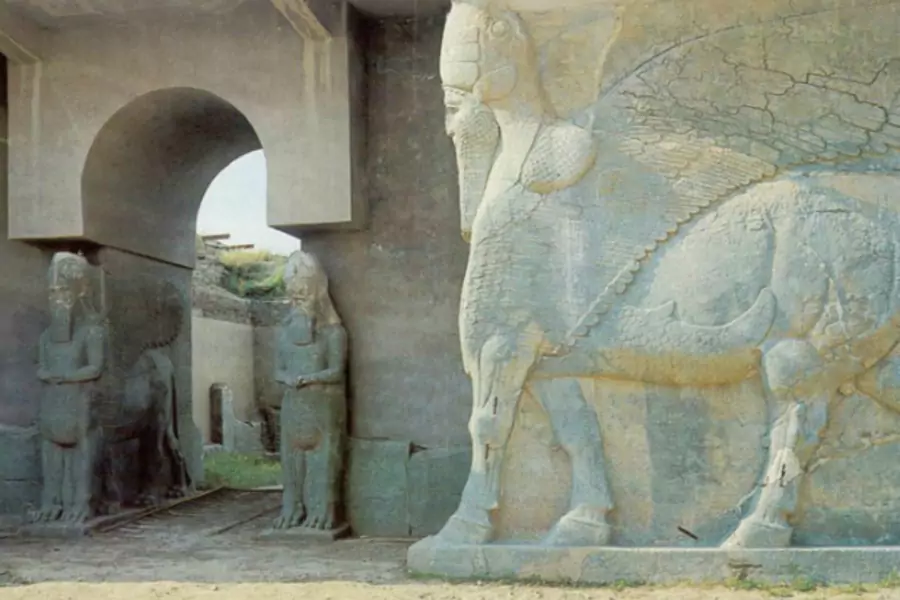Guest Post: Preventing Cultural Destruction by ISIS

More on:
Diplomacy and International Institutions
Aliza Litchman is an intern in the Center for Preventive Action at the Council on Foreign Relations.
The U.S.-led coalition has been unsuccessful in halting the Islamic State in Iraq and Syria’s (ISIS or ISIL) second largest revenue stream: illegal artifacts. A March 6 UNESCO report attempted to call attention to the ISIS’ bulldozing of the three thousand-year-old city of Nimrud, and a February 25 video shows ISIS militants ransacking the central museum in Mosul. However, the most damage to Iraq and Syria’s cultural heritage is not inflicted with bulldozers and sledgehammers, but through illegal sales in foreign markets, which have thus far provided ISIS with over $100 million U.S. officials estimate. Antiquities dealings are ISIS’ second largest source of funding, and control of over four thousand archaeological sites ensures this revenue source will not expire.
For terrorist groupsoperating in the cradle of civilization, ancient sites are cash cows that are readily taken advantage of. Artifacts travel across countries through secret smuggling routes passed down in local families for generations, and sold to contacts in foreign countries who then sell to antique dealers. The number of middle men and labyrinth of routes make it difficult to decipher who dug up the artifacts and track where the money is going. As a result, less than 1 percent of the artifacts looted by ISIS from Iraq and Syria have been recovered. Since the Syrian civil war began, foreign interest in Syrian antiquities has ballooned. In the United States alone,the value of declared antiquities imported from Syria jumped 134 percent in 2013 to $11 million…the undeclared pieces is many multiples higher.”
Though the United States has taken concrete steps to stem the flow of terrorist funding by preserving Iraqi and Syrian cultural heritage, it is not achieving results. In 2014, Secretary of State John Kerry affirmed the U.S. commitment to protecting artifacts by stating, “ISIL is not only beheading individuals; it is tearing at the fabric of whole civilizations…President Obama and our administration are laser-focused on protecting the cultural heritage of countries all around the world…Our heritage is literally in peril in this moment, and we believe it is imperative that we act now.”
The United States embarked on multiple initiatives aimed at targeting ISIS’ illegal antiquities sales. The State Department (DOS) teamed with the American Schools of Oriental Research and the American Association for the Advancement of Science, started the Syria Cultural Heritage Initiative, and funded the Iraqi Institute for the Conservation of Antiques and Heritage. Collectively, these efforts document damage, promote global awareness, and minimize the impact of damage through preservation projects and attempts to retrieve looted artifacts. However, these initiatives are limited to observing, documenting, retrieving, and repairing destroyed sites, without preventively stopping the damage by dissuading ISIS from continuing its assault on Iraq and Syria’s cultural heritage. While the U.S. government identifies the illegal sale of Syrian and Iraqi cultural heritage as a problem and a source of terrorist funding, preventive efforts have not been instituted or well-funded by government agencies.
The United States can pursue a few steps to stop ISIS from using artifact sales for financial gain. First, the Terrorist Finance Tracking Program—the main government agency in control of stemming terrorist funding—is not currently tasked with illegal antiquities dealings and should recognize it as a main source of terrorist funding. This will raise its priority and awareness among U.S. officials. Second, the U.S. government should provide financial support to local institutions and individuals actively protecting artifacts. For example, this could include the Heritage Task Force that was established by the Syrian interim government’s Ministry of Culture and Family Affairs and collaborates with international and non-governmental organizations, and community groups to protect Syrian heritage. This task force instituted emergency training programs for museum curators to protect museums and at risk archaeological sites—a preventive effort that could be expanded with adequate support and funding.
There are U.S. government individuals hunting down illegal artifacts overseas as part of the Department of Homeland Security’s Cultural Property, Art and Antiquities Investigations and Repatriations Program. However, these individuals are not utilized or funded to disrupt ISIS’ illegal artifact smuggling networks or retrieve looted antiquities sold to fund terrorism. The United States should also heed the United Nation’s call for “Protected Cultural Zones” by incorporating cultural heritage rescue and protection training within the regular training of Iraqi forces and Syrian rebels. Finally, the United States should pass the Protect and Preserve International Cultural Property Act that was dismissed last year. The act would make retrieving artifacts a priority for the Office of Foreign Asset Control and the Department of Defense, and ensure efficient collaboration among diplomatic, military, and law enforcement Federal agencies.
More on:
Diplomacy and International Institutions
 Online Store
Online Store